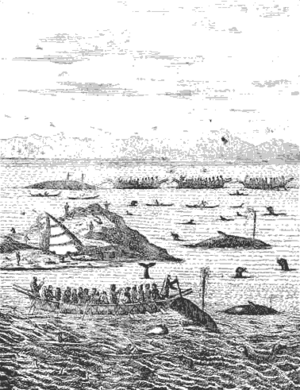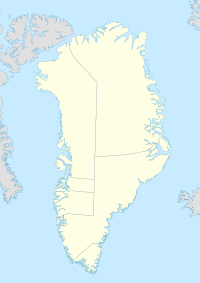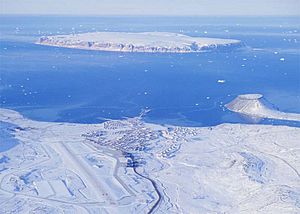Comer's Midden facts for kids
Quick facts for kids Comer's Midden |
|
|---|---|
| Created | Thule culture |
| Discovered | 1916 |
| Present location | Near Pituffik, Greenland |
Comer's Midden is an important archaeological site in Greenland. It was first dug up in 1916. This site is very special because the entire Thule culture was named after discoveries made here. The Thule people were ancestors of today's Inuit people.
The site is located near Qaanaaq (formerly Thule) in northern Greenland. It's found north of Mt. Dundas in North Star Bay. The first people to dig here were Captain George Comer and members of Knud Rasmussen's Second Danish Thule Expedition.
Contents
Digging Up the Past
The Comer's Midden site was explored in different stages over many years. Each time, more was learned about the ancient people who lived there.
The First Dig: 1916
In 1916, Captain George Comer's ship was stuck in ice. To make good use of his time, he started digging near the Arctic Station of Thule. He uncovered a "kitchen-midden," which is basically an ancient trash pile. This midden was made by paleo-Eskimos, who were early Inuit people. The site was named Comer's Midden to honor him and his discovery.
More Expeditions: 1920s
Later, in the 1920s, an anthropologist named Therkel Mathiassen visited the site. He was part of Rasmussen's 5th Thule Expedition. Mathiassen wrote important books about his findings. He described Comer's Midden as the most significant discovery of pure Thule culture in all of Greenland.
Later Excavations: 1930s and 1940s
The site was dug up again several times by Erik Holtved. He worked there from 1935 to 1937, and then again from 1946 to 1947. These later digs helped scientists learn even more about the site.
What Was Found?
Archaeologists found many interesting things at Comer's Midden. These discoveries tell us a lot about the lives of the Thule people.

When People Lived There
The site shows that people lived there for a long time. It was used from the 14th century all the way to the 20th century. However, there are fewer signs of people living there during the 17th and 18th centuries.
Old Buildings and Homes
About 26 old house ruins were found at the site. There were also several middens, or trash piles. These ruins spread out over an area about 120 meters wide and 400 meters inland. The midden that Captain Comer first found was at the south end.
Most of the houses were round, usually about 3 to 5 meters across. These were likely homes where families lived. One house was different; it was rectangular, about 4.5 by 6 meters. It had narrow platforms along two of its walls. This larger building was probably a "qassi," or "men's house." It would have been used as a workshop and a place for social gatherings.
Tools and Objects
Many artifacts were found at Comer's Midden. Some items belonged to the Dorset culture, which was another ancient group. There were also some objects that came from Norsemen, or Vikings.
Most of the harpoon heads found were of a type called "open socket." This style was very common for the Thule culture. These harpoons were important tools for hunting sea animals.
A New Home
In 1910, Knud Rasmussen and Peter Freuchen set up a trading post called Cape York. Local Inuit people also created a settlement nearby called Uummannaq, which was known as Dundas in English.
However, in 1953, Dundas and a nearby area called Pituffik were turned into Thule Air Force Base. Because of this, the people living there had to move. They were relocated to a new town called Qaanaaq.



